The Effects of Different Crop Rotations on the Quality of Saline Soils in the Yinbei Plain
Abstract
1. Introduction
2. Materials and Methods
2.1. Site Description
2.2. Experimental Design and Management
2.3. Collection of Soil Sample and Preparation
2.4. Soil Particle Fractal Dimension (D), Soil Structural Stability Coefficient (SI), and Soil Quality Index (SQI)
- (1)
- The principal component analysis (PCA) was used to analyze the 16 soil indicators, extract the common factor variance of each indicator, and calculate the ratio of the common factor variance of the indicators to the sum of the common factor variance to obtain the weight value of each indicator.
- (2)
- A linear computational model was used to convert the soil indicator data into dimensionless scores from 0 to 1. In this study, the “more the better” (3) and the “less the better” type indicator scoring functions (4) were used.where represents the linear index score (0~1), represents the measured value of the index, Xmax represents the maximum value of the index, and Xmin represents the minimum value of the index.
- (3)
- The soil quality index (SQI) was calculated using Equation (5), with higher SQI values indicating better soil quality.where SQI is the soil quality index, is the weight value of the index, and is the score of the th index.
2.5. Statistical Analysis
3. Results
3.1. Effect of Different Crop Rotations on Soil Particle Composition
3.2. Effect of Different Crop Rotations on Fractal Dimension and Structural Stability Indices
3.3. Influence of Different Crop Rotations on Soil Physicochemical Properties
3.4. Effect of Different Crop Rotations on Soil Enzyme Activities
3.5. Effect of Different Crop Rotations on Soil Quality
3.6. Mantel Correlation Analysis Between Soil Quality Index and Soil Texture, Physical and Chemical Properties, and Enzyme Activities
3.7. Structural Equation Model
4. Discussion
4.1. Effects of Different Crop Rotation Methods on Soil Particle Composition, Fractal Dimension, and Structural Stability Coefficient
4.2. Effects of Different Crop Rotations on Soil Physical and Chemical Properties and Enzyme Activities
4.3. Effect of Different Crop Rotations on Soil Quality
5. Conclusions
- (1)
- The saline soil in Yinbei Plain, where rice is grown all the year round, was chalky, and different rice–dry rotations changed the soil texture from chalky to chalky loam, improving the soil fractal dimension. The fractal dimension of saline soil was positively correlated with the volume content of clay particles, negatively correlated with the volume content of powder particles, and negatively correlated with the volume content of sand particles.
- (2)
- There is no structural degradation sub-risk (SI > 9%) in perennial rice saline soil, and RS (rice–soybean) can better improve the soil structure stabilization coefficient of the 0~40 cm soil layer.
- (3)
- Different rice–dry crop rotations can significantly affect soil physicochemical properties and enzyme activities, RS treatment (rice–soybean) can comprehensively improve soil fertility and is suitable for fertilizing the land, and RSS treatment (rice–sweet sorghum) has outstanding effects on phosphorus- and potassium-deficient soil restoration. The quality assessment of the soil in the 0–40 cm soil layer showed that RS (rice–soybean) and RC (rice–corn) had higher soil quality indices, which could better improve the soil quality of the 0–40 cm layer, and were suitable rice–dry rotations in the north of Yinbei. Structural equation modeling indicated that salinity factor and soil nutrients were the key factors limiting the improvement of saline soil quality in the north Yin area.
Author Contributions
Funding
Data Availability Statement
Conflicts of Interest
References
- Li, C.Y.; He, R.; Tian, C.Y.; Song, J. Utilization of halophytes in saline agriculture and restoration of contaminated salinized soils from genes to ecosystem: Suaeda salsa as an example. Mar. Pollut. Bull. 2023, 197, 115728. [Google Scholar] [CrossRef]
- Zhang, K.; Chang, L.; Li, G.; Li, Y. Advances and future research in ecological stoichiometry under saline-alkali stress. Environ. Sci. Pollut. Res. 2023, 30, 5475–5486. [Google Scholar] [CrossRef]
- Wang, Y.; Jie, W.; Peng, X.; Hua, X.; Yan, X.; Zhou, Z.; Lin, J. Physiological Adaptive Strategies of Oil Seed Crop Ricinus communis Early Seedlings (Cotyledon vs. True Leaf) Under Salt and Alkali Stresses: From the Growth, Photosynthesis and Chlorophyll Fluorescence. Front. Plant Sci. 2018, 9, 1939. [Google Scholar] [CrossRef] [PubMed]
- Luo, S.; Wang, S.; Tian, L.; Shi, S.; Xu, S.; Yang, F.; Li, X.; Wang, Z.; Tian, C. Aggregate-related changes in soil microbial communities under different ameliorant applications in saline-sodic soils. Geoderma 2018, 329, 108–117. [Google Scholar] [CrossRef]
- Yao, R.; Gao, Q.; Liu, Y.; Li, H.; Yang, J.; Bai, Y.; Zhu, H.; Wang, X.; Xie, W.; Zhang, X. Deep vertical rotary tillage mitigates salinization hazards and shifts microbial community structure in salt-affected anthropogenic-alluvial soil. Soil Till. Res. 2023, 227, 14. [Google Scholar] [CrossRef]
- Mokhtaran, A.; Sepehri, S.; Gilani, A.A.; Ebadi, A.A.; Jalali, S. Improving Rice Production Sustainability by Planting Salinity-Tolerant Rice Cultivars and Reusing Agricultural Drainage Water. J. Irrig. Drain. Eng. 2023, 149, 9. [Google Scholar] [CrossRef]
- Duran-Flores, D.; Heil, M. Growth inhibition by self-DNA: A phenomenon and its multiple explanations. New Phytol. 2015, 207, 482–485. [Google Scholar] [CrossRef]
- Luo, L.; Guo, C.; Wang, L.; Zhang, J.; Deng, L.; Luo, K.; Huang, H.; Liu, Y.; Mei, X.; Zhu, S.; et al. Negative Plant-Soil Feedback Driven by Re-assemblage of the Rhizosphere Microbiome with the Growth of Panax notoginseng. Front. Microbiol. 2019, 10, 13. [Google Scholar] [CrossRef] [PubMed]
- Bai, N.; Lv, W.; Chu, X.; Fan, H.; Li, S.; Zheng, X.; Zhang, J.; Zhang, H.; Zhang, H. Comparison of soil microbial community and physicochemical properties between rice-fallow and rice-bean (green manure) rotation. Soil Sci. Soc. Am. J. 2022, 86, 593–603. [Google Scholar] [CrossRef]
- Ge, S.; Chen, Y.; Wang, Z.; Li, Z.; Shen, C.; Zhang, T.; Wang, J. Deep insights into the diversified cropping and their impact on arbuscular mycorrhizal fungi: A global meta-analysis. Agric. Ecosyst. Environ. 2025, 383, 11. [Google Scholar] [CrossRef]
- Obour, P.B.; Xia, Y.; Ugarte, C.M.; Grift, T.E.; Wander, M.M. Soil physical properties and water dynamics under contrasting management regimes at the Morrow Plots. Soil Till. Res. 2025, 248, 9. [Google Scholar] [CrossRef]
- Sun, Q.; Zheng, Y.; Li, S.; Yang, J.; Zhao, X.; Du, L.; He, K.; Liu, J. Diversified crop rotation: Synergistically enhancing peanut yield and soil organic carbon stability. Agric. Ecosyst. Environ. 2025, 382, 13. [Google Scholar] [CrossRef]
- Zhao, Z.; Zhou, H.; Chen, W.; Wu, Y.; Liu, G.; Xue, S. Response of soil structure and fertility to long-term fertilization in alpine grasslands revealed based on fractal theory. Soil Till. Res. 2024, 242, 12. [Google Scholar] [CrossRef]
- Al-Kayssi, A.W. Quantifying soil physical quality by using indicators and pore volume-function characteristics of the gypsiferous soils in Iraq. Geoderma Reg. 2022, 30, 13. [Google Scholar] [CrossRef]
- Biswas, S.; Hazra, G.C.; Purakayastha, T.J.; Saha, N.; Mitran, T.; Roy, S.S.; Basak, N.; Mandal, B. Establishment of critical limits of indicators and indices of soil quality in rice-rice cropping systems under different soil orders. Geoderma 2017, 292, 34–48. [Google Scholar] [CrossRef]
- Yu, P.; Han, D.; Liu, S.; Wen, X.; Huang, Y.; Jia, H. Soil quality assessment under different land uses in an alpine grassland. Catena 2018, 171, 280–287. [Google Scholar] [CrossRef]
- Bansal, S.; Wang, T.; Osborne, S.L. Yield and Profit Comparison of Diversified Versus Conventional Crop Rotation Systems in South Dakota. Agron. J. 2024, 116, 3145–3157. [Google Scholar] [CrossRef]
- Malobane, M.E.; Nciizah, A.D.; Mudau, F.N.; Wakindiki, I.I.C. Soil Organic Carbon and Labile Carbon Pools Attributed by Tillage, Crop Residue and Crop Rotation Management in Sweet Sorghum Cropping System. Sustainability 2020, 12, 9782. [Google Scholar] [CrossRef]
- Tyler, S.W.; Wheatcraft, S.W. Fractal Scaling of Soil Particle-Size Distributions: Analysis and Limitations. Soil Sci. Soc. Am. J. 1992, 56, 362–369. [Google Scholar] [CrossRef]
- Reynolds, W.D.; Drury, C.F.; Tan, C.S.; Fox, C.A.; Yang, X.M. Use of Indicators and Pore Volume-Function Characteristics to Quantify Soil Physical Quality. Geoderma 2009, 152, 252–263. [Google Scholar] [CrossRef]
- Chang, F.; Zhang, H.; Song, J.; Yu, R.; Zhang, X.; Li, H.; Wang, J.; Kan, Z.; Li, Y. Once-middle Amount of Straw Interlayer Enhances Saline Soil Quality and Sunflower Yield in Semi-Arid Regions of China: Evidence from a Four-Year Experiment. J. Environ. Manag. 2023, 344, 118530. [Google Scholar] [CrossRef]
- Zhang, Y.; Zhong, X.; Lin, J.; Zhao, D.; Jiang, F.; Wang, M.; Ge, H.; Huang, Y. Corrigendum to “effects of Fractal Dimension and Water Content on the Shear Strength of Red Soil in the Hilly Granitic Region of Southern China” [geomorphology 351 (15 February 2020) 106956]. Geomorphology 2020, 360, 107207. [Google Scholar] [CrossRef]
- Gao, Z.; Niu, F.; Lin, Z.; Luo, J. Fractal and Multifractal Analysis of Soil Particle-Size Distribution and Correlation with Soil Hydrological Properties in Active Layer of Qinghai–Tibet Plateau, China. Catena 2021, 203, 105373. [Google Scholar] [CrossRef]
- Wang, Z.; Hasi, E.; Han, X.; Qingda, M. Fractal Characterization of Soil Particle Size Distribution under Different Land Use Patterns on the North Slope of Wula Mountain in China. J. Soil Sediment. 2024, 24, 1148–1164. [Google Scholar] [CrossRef]
- Pieri, C. Fertility of Soils: A Future for Farming in the West African Savannah; Springer: Berlin/Heidelberg, Germany, 1992. [Google Scholar]
- Yang, J.; Zhou, Y.; Ye, X.; Liu, E.; Sun, S.; Ren, X.; Jia, Z.; Wei, T.; Zhang, P. Continuous Ridge-Furrow Film Mulching Enhances Maize Root Growth and Crop Yield by Improving Soil Aggregates Characteristics in a Semiarid Area of China: An Eight-Year Field Experiment. Plant Soil 2024, 499, 173–191. [Google Scholar] [CrossRef]
- Zhang, Y.; Li, Y.; Ren, X.; Gao, J.; Wang, Y.; Zhu, D. Comparative Study on the Nutritional Quality of Peanut in Saline and Non-Saline Land. Foods 2024, 13, 3751. [Google Scholar] [CrossRef]
- Sun, X.; Wang, W.; Yi, S.; Zheng, F.; Zhang, Z.; Alharbi, S.A.; Filimonenko, E.; Wang, Z.; Kuzyakov, Y. Microbial Composition in Saline and Alkaline Soils Regulates Plant Growth with P-solubilizing Bacteria. Appl. Soil Ecol. 2024, 203, 105653. [Google Scholar] [CrossRef]
- Zhang, Q.; Song, Y.; Wu, Z.; Yan, X.; Gunina, A.; Kuzyakov, Y.; Xiong, Z. Effects of Six-Year Biochar Amendment on Soil Aggregation, Crop Growth, and Nitrogen and Phosphorus Use Efficiencies in a Rice-Wheat Rotation. J. Clean. Prod. 2019, 242, 118435. [Google Scholar] [CrossRef]
- Zong, M.; Yang, X.; Sanz-Cobena, A.; Jorgensen, U.; Butterbach-Bahl, K.; Abalos, D. Reductions in Nitrous Oxide Emissions in Diverse Crop Rotations Linked to Changes in Prokaryotic Community Structure. Agric. For. Meteorol. 2025, 362, 110370. [Google Scholar] [CrossRef]
- Xu, F.; Song, T.; Wang, K.; Xu, W.; Chen, G.; Xu, M.; Zhang, Q.; Liu, J.; Zhu, Y.; Rensing, C.; et al. Frequent Alternate Wetting and Drying Irrigation Mitigates the Effect of Low Phosphorus on Rice Grain Yield in a 4-year Field Trial by Increasing Soil Phosphorus Release and Rice Root Growth. Food Energy Secur. 2020, 9, e206. [Google Scholar] [CrossRef]
- Hou, J.; Gao, X.; Entz, M.H. Enhancing Zinc and Iron Bioavailability Through Crop Rotation and Organic Farming: Insights from a Long-Term Study. Field Crop Res. 2025, 322, 109710. [Google Scholar] [CrossRef]
- Yang, C.M.; Yang, L.Z.; Yang, Y.X.; Zhu, O.Y. Rice Root Growth and Nutrient Uptake As Influenced by Organic Manure in Continuously and Alternately Flooded Paddy Soils. Agric. Water Manag. 2004, 70, 67–81. [Google Scholar] [CrossRef]
- Hou, P.; Chien, C.; Chiang-Hsieh, Y.; Tseng, K.; Chow, C.; Huang, H.; Chang, W. Paddy-upland Rotation for Sustainable Agriculture with Regards to Diverse Soil Microbial Community. Sci. Rep. 2018, 8, 7966. [Google Scholar] [CrossRef]
- Gaiero, J.R.; McCall, C.A.; Thompson, K.A.; Day, N.J.; Best, A.S.; Dunfield, K.E. Inside the Root Microbiome: Bacterial Root Endophytes and Plant Growth Promotion. Am. J. Bot. 2013, 100, 1738–1750. [Google Scholar] [CrossRef]
- Hu, J.; Wei, Z.; Friman, V.; Gu, S.; Wang, X.; Eisenhauer, N.; Yang, T.; Ma, J.; Shen, Q.; Xu, Y.; et al. Probiotic Diversity Enhances Rhizosphere Microbiome Function and Plant Disease Suppression. MBio 2016, 7, 10-1128. [Google Scholar] [CrossRef] [PubMed]
- Zhu, M.; Ai, X.; Sheng, M.; Ai, S.; Miao, N.; Ai, Y. Using a Soil Quality Index to Evaluate the Artificial Soil Quality Response to Rehabilitation Time. Ecol. Eng. 2024, 202, 107234. [Google Scholar] [CrossRef]
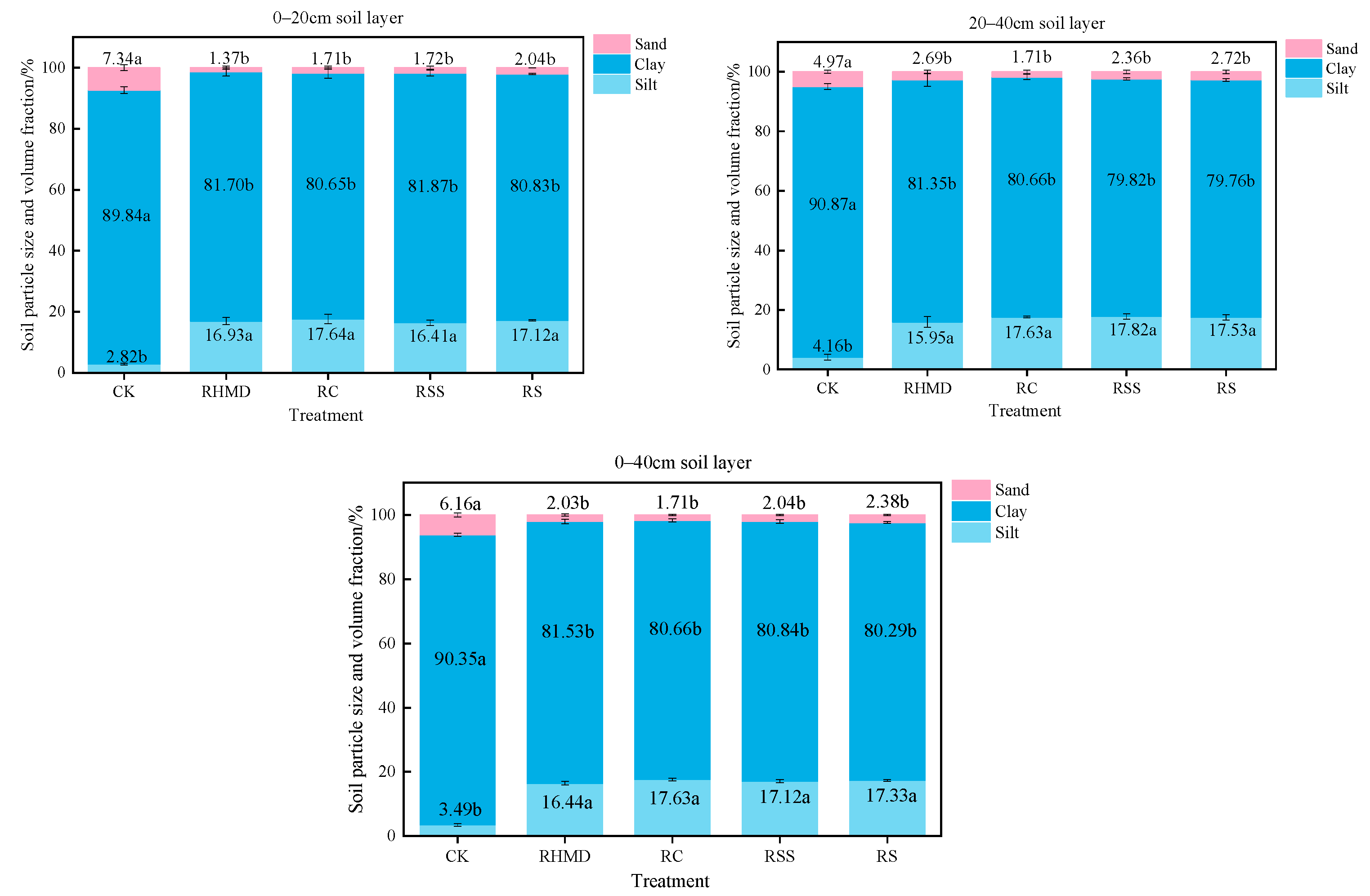
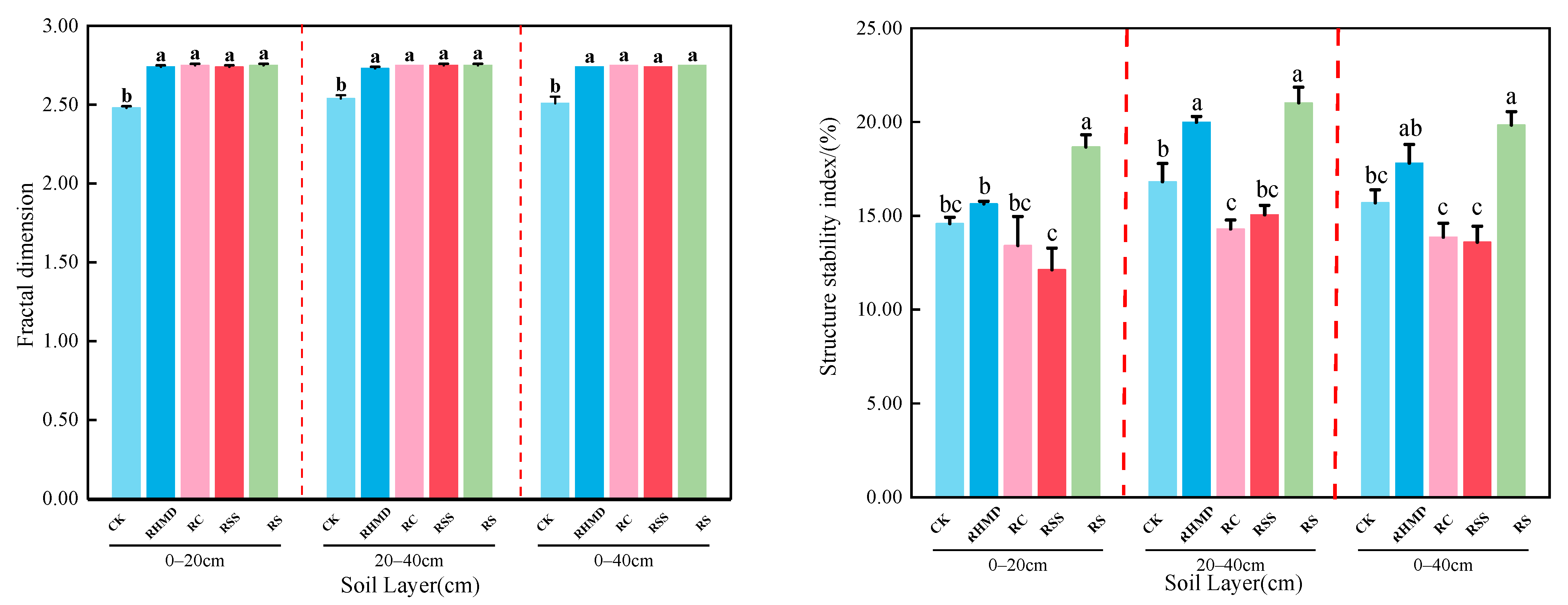
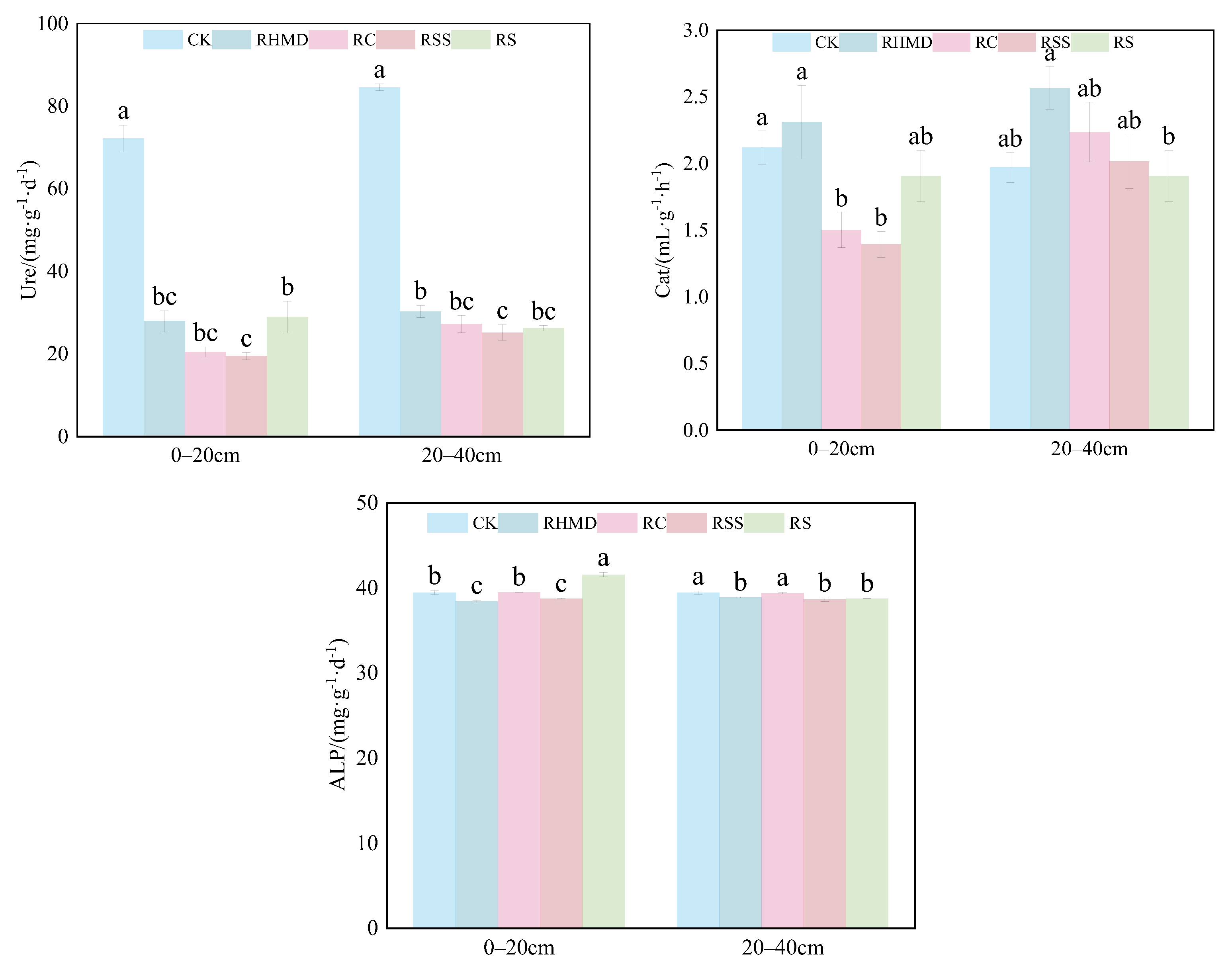
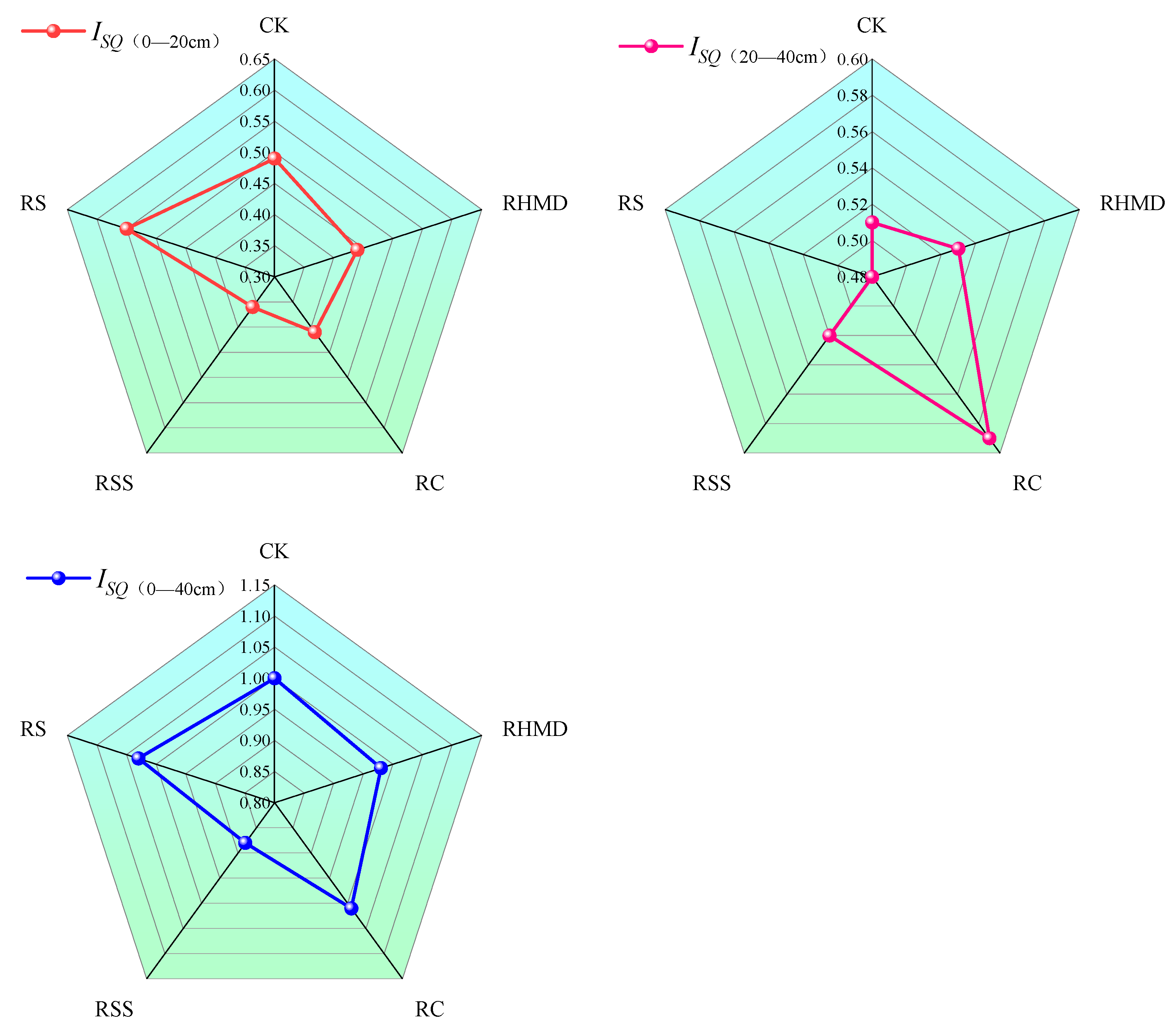
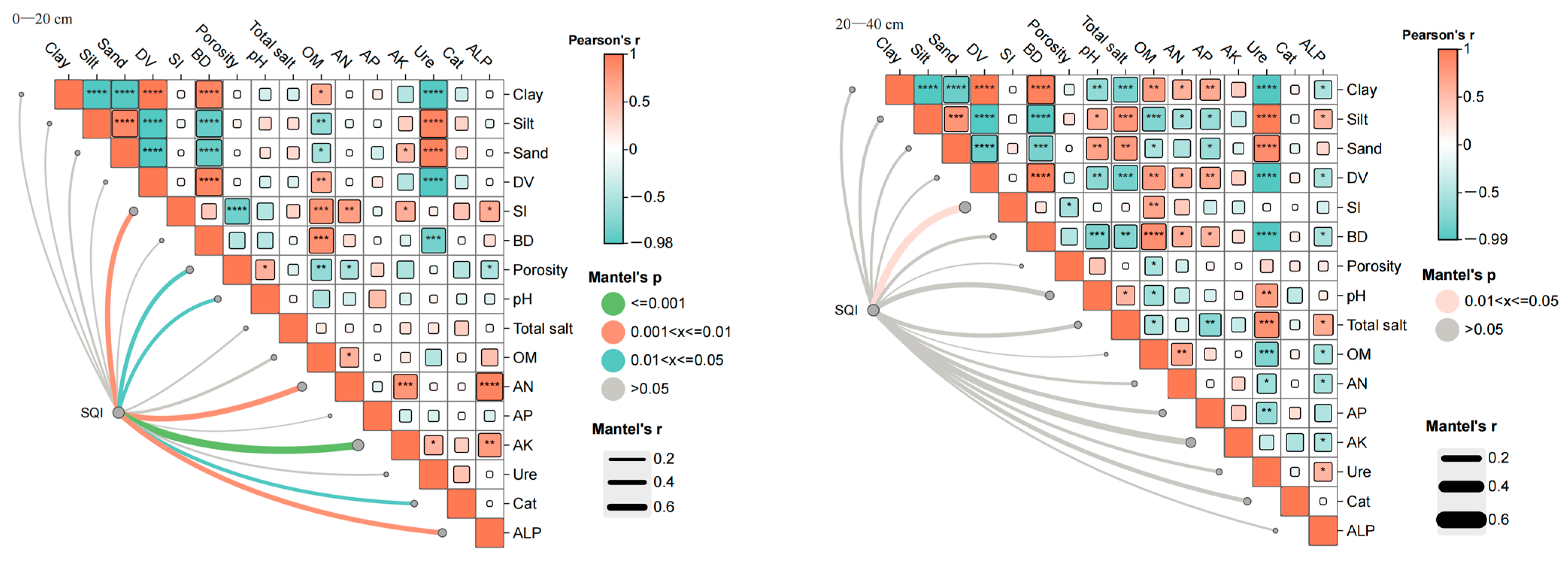
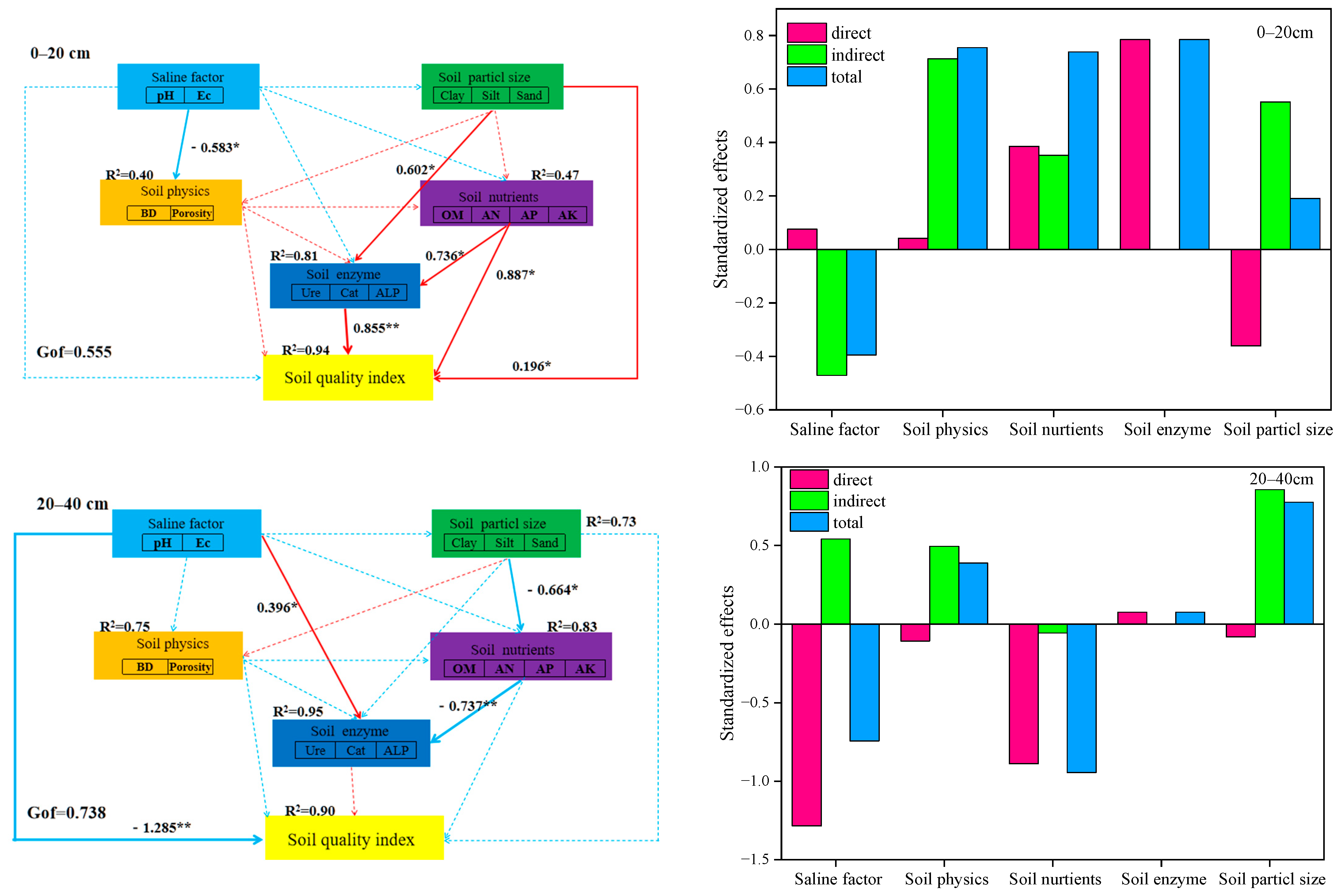
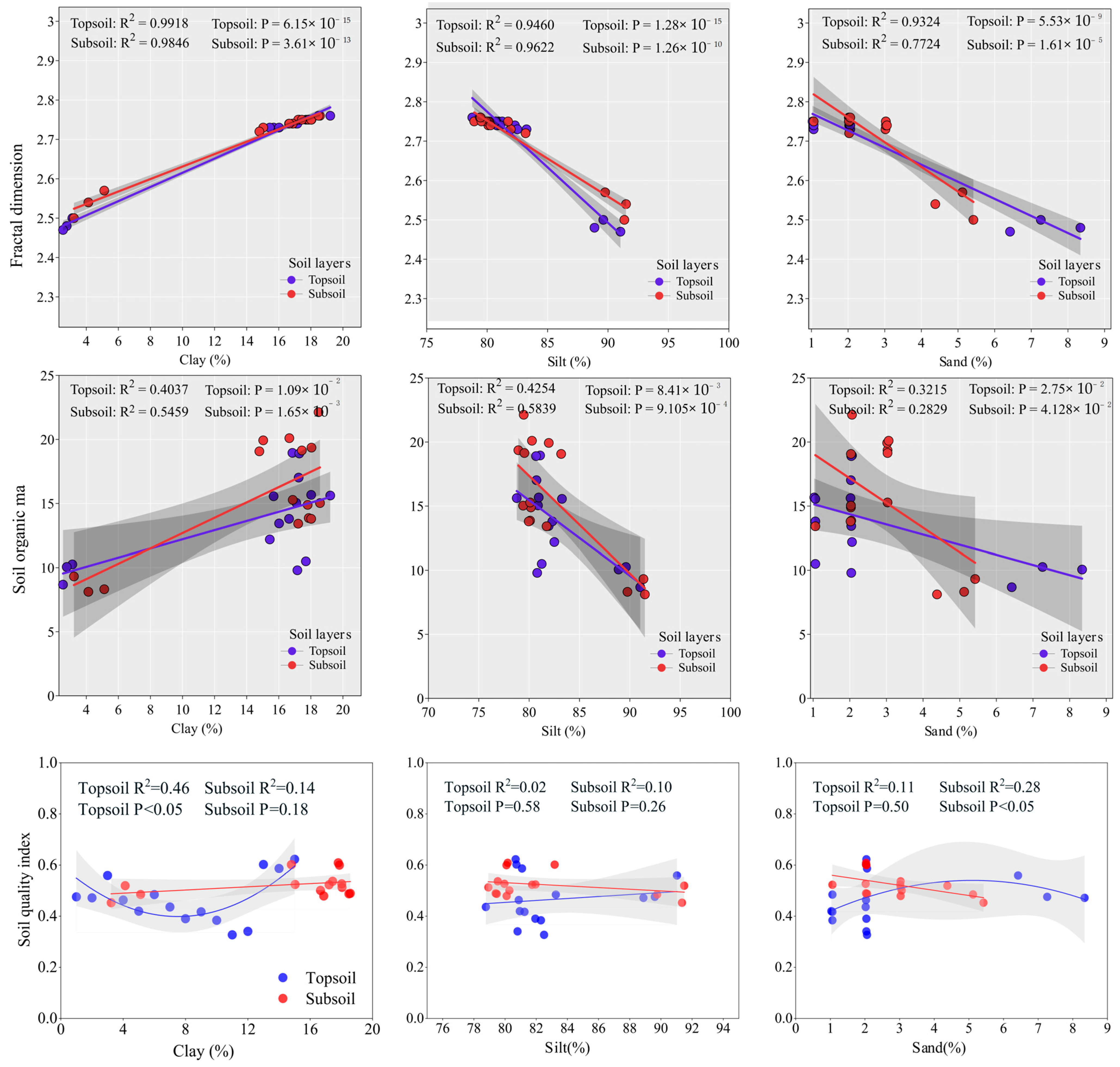
| Soil Layer | pH | Ec (ds/m) | OM (g/kg) | AN (mg/kg) | AP (mg/kg) | AK (mg/kg) |
|---|---|---|---|---|---|---|
| 0–20 cm | 8.56 | 4.62 | 13.42 | 48.12 | 30.68 | 83.69 |
| 20–40 cm | 8.78 | 5.79 | 10.07 | 40.69 | 23.44 | 70.12 |
| Treatment | Soil Depth (cm) | BD/(g/cm3) | Porosity (%) | pH | Total Salt/(g/kg) | OM/(g/kg) | AN/(mg/kg) | AP/(mg/kg) | AK/(mg/kg) |
|---|---|---|---|---|---|---|---|---|---|
| CK | 0–20 cm | 1.27 ± 0.02 a | 51.95 ± 0.63 a | 8.59 ± 0.01 b | 3.20 ± 0.04 a | 13.52 ± 0.37 bc | 55.65 ± 5.05 b | 26.42 ± 2.86 ab | 62.58 ± 1.66 b |
| 20–40 cm | 1.35 ± 0.02 a | 49.06 ± 0.66 a | 8.64 ± 0.01 ab | 2.78 ± 0.03 a | 15.98 ± 0.87 b | 60.32 ± 1.68 b | 23.09 ± 1.52 c | 60.28 ± 1.24 c | |
| RHMD | 0–20 cm | 1.31 ± 0.01 a | 50.46 ± 0.41 a | 8.48 ± 0.01 c | 2.00 ± 0.18 b | 15.43 ± 0.19 b | 37.45 ± 1.07 c | 28.69 ± 2.79 ab | 53.12 ± 2.25 c |
| 20–40 cm | 1.39 ± 0.02 a | 47.60 ± 1.07 a | 8.55 ± 0.08 ab | 1.86 ± 0.18 b | 19.45 ± 0.25 a | 50.87 ± 4.16 b | 37.95 ± 1.67 b | 59.74 ± 1.11 c | |
| RC | 0–20 cm | 1.29 ± 0.02 a | 51.33 ± 0.33 a | 8.47 ± 0.02 c | 1.78 ± 0.21 b | 13.19 ± 1.48 bc | 42.93 ± 1.88 c | 21.56 ± 2.12 b | 57.17 ± 0.94 c |
| 20–40 cm | 1.41 ± 0.07 a | 46.70 ± 2.73 a | 8.51 ± 0.02 b | 2.04 ± 0.20 b | 14.06 ± 0.44 b | 52.15 ± 5.05 b | 34.42 ± 2.15 b | 65.15 ± 2.04 b | |
| RSS | 0–20 cm | 1.28 ± 0.03 a | 51.86 ± 2.48 a | 8.73 ± 0.02 a | 1.90 ± 0.18 b | 11.93 ± 1.16 c | 36.28 ± 0.84 c | 33.15 ± 2.32 a | 43.97 ± 1.84 d |
| 20–40 cm | 1.40 ± 0.02 a | 47.01 ± 0.84 a | 8.68 ± 0.02 a | 1.79 ± 0.17 b | 14.70 ± 0.46 b | 56.93 ± 3.96 b | 47.95 ± 0.87 a | 76.40 ± 1.73 a | |
| RS | 0–20 cm | 1.32 ± 0.01 a | 50.17 ± 0.77 a | 8.51 ± 0.05 c | 2.03 ± 0.21 b | 18.29 ± 0.64 a | 69.18 ± 3.06 a | 27.56 ± 1.83 ab | 83.93 ± 1.52 a |
| 20–40 cm | 1.46 ± 0.01 a | 45.03 ± 0.34 a | 8.59 ± 0.03 ab | 2.15 ± 0.15 b | 20.46 ± 0.88 a | 74.20 ± 3.45 a | 24.76 ± 2.02 c | 69.47 ± 1.16 b | |
| Treatment (T) | 1.31 | 1.28 | 13.44 ** | 16.27 ** | 22.39 ** | 22.98 ** | 19.11 ** | 47.67 ** | |
| Depth (D) | 24.10 ** | 24.39 ** | 3.17 | 0.30 | 24.71 ** | 24.73 ** | 21.69 ** | 35.73 ** | |
| T*D | 0.32 | 0.36 | 1.26 | 1.22 | 1.06 | 1.95 | 8.56 ** | 58.01 ** | |
Disclaimer/Publisher’s Note: The statements, opinions and data contained in all publications are solely those of the individual author(s) and contributor(s) and not of MDPI and/or the editor(s). MDPI and/or the editor(s) disclaim responsibility for any injury to people or property resulting from any ideas, methods, instructions or products referred to in the content. |
© 2025 by the authors. Licensee MDPI, Basel, Switzerland. This article is an open access article distributed under the terms and conditions of the Creative Commons Attribution (CC BY) license (https://creativecommons.org/licenses/by/4.0/).
Share and Cite
Wu, J.; Zhang, B.; Lin, M.; Bu, R.; Bai, X.; Zhang, X.; Liu, P.; Wang, B. The Effects of Different Crop Rotations on the Quality of Saline Soils in the Yinbei Plain. Agronomy 2025, 15, 2131. https://doi.org/10.3390/agronomy15092131
Wu J, Zhang B, Lin M, Bu R, Bai X, Zhang X, Liu P, Wang B. The Effects of Different Crop Rotations on the Quality of Saline Soils in the Yinbei Plain. Agronomy. 2025; 15(9):2131. https://doi.org/10.3390/agronomy15092131
Chicago/Turabian StyleWu, Jinmin, Bangyan Zhang, Meiling Lin, Rui Bu, Xiaolong Bai, Xiaoli Zhang, Panting Liu, and Bin Wang. 2025. "The Effects of Different Crop Rotations on the Quality of Saline Soils in the Yinbei Plain" Agronomy 15, no. 9: 2131. https://doi.org/10.3390/agronomy15092131
APA StyleWu, J., Zhang, B., Lin, M., Bu, R., Bai, X., Zhang, X., Liu, P., & Wang, B. (2025). The Effects of Different Crop Rotations on the Quality of Saline Soils in the Yinbei Plain. Agronomy, 15(9), 2131. https://doi.org/10.3390/agronomy15092131





